ISSN ONLINE(2319-8753)PRINT(2347-6710)
ISSN ONLINE(2319-8753)PRINT(2347-6710)
Abeer S. Meganid1, Hassan S. Al-Zahrani1, EL-Metwally, M. Selim2
|
| Related article at Pubmed, Scholar Google |
Visit for more related articles at International Journal of Innovative Research in Science, Engineering and Technology
Pot experiment was carried out at the research greenhouseof the King Abdul-Aziz University, Jeddah, Saudi Arabia to study the effect of humic acid (HA)on biological aspects (plant height, number of leaves and root length and plant growth biomass as well as chlorophyll contents) of common bean plants (Phaseolus vulgaris L.) under salinity stress conditions at 15, 30 and 45 days after planting (DAP).Four different salinity levels (0, 25, 50 and 100 mMNaCl) combined with and without HA supply at 3g L–1) in split plot design with three replicates were assigned. Results indicated that HAsupply significantly increased plant height, number of leaves, root length, shoot and root fresh and dry weights as well as chlorophyll contents of common bean than control plants at 15, 30 and 45 DAP, respectively. While, no significant responding was found for shoot fresh weigh at 15 DAP and root fresh weight at 30 DAP.Salt stress significantly declined the plant morphological and fresh and dry biomass as well as chlorophyllcontents and leaf area in shoot leaves. Application of HA markedly mitigated the adverse effects of a biotic stress on all studied biological aspects. Lastly, humic acid supply significantly increased the relative growth rates of shoot and root under saline conditions and humic is considered as a promising soil amendment to overcome adverse effects of salinity stress.
Keywords |
| High Pressure coolant; Surface Finish; Roughness Average; Average Maximum Height of the Profile. |
INTRODUCTION |
| In the process of machining, a tool penetrates into the workpiece and removes the material in the form of chips. A major portion of the energy is consumed in the formation and removal of chips. The greater the energy consumption, the greater are the temperature and frictional forces at the tool–chip interface and consequently the higher is the tool wear. Flood or conventional coolant is applied to remove the heat generated at the cutting zone. During machining especially of very hard materials, much heat is generated by the friction of the cutter against the workpiece, which is one of the major causes of reduction in tool hardness and rapid tool wear [9]. However, high pressure jet of soluble oil, if applied at the chip-tool interface, the wedge formation by the jet may lift up the chip, segregating it and could break the vapor barrier and reduce cutting temperature and improve tool life The combination of reduced heat and more efficient evacuation of chips prolong tool life and makes replacement more predictable because the cutting tool wears out naturally rather than failing prematurely because of excessive heat or chip damage [1]. Application of pressurized coolant jet for effective cooling without polluting the environment is becoming more popular day by day. But in addition to pollution control, the industries also reasonably insist economic viability through technological benefits in terms of product quality, tool life and saving power consumption by the application of pressurized jet cooling. So it has become essential to study the role of high- pressure cooling on cutting temperature, chips, cutting force, tool wear, tool life and surface quality of the product in machining where high cutting temperature is the major concern. Therefore, there have been several studies on applying coolant at high pressure at the tool–chip interface, focused on a stationary single cutting edge in a turning operation. The performance of high-pressure coolant is investigated by focusing on cutting forces, surface finish, tool wear, and chip shape, which are compared against dry cut and conventional coolant. Cooling is important in reducing the severity of the contact processes at the cutting toolwork piece interfaces [8]. |
II. BENEFITS OF HIGH PRESSURE COOLANT |
| High pressure coolant can provide the following benefits especially in challenging work piece materials [3,7]. |
| a) Higher machining security |
| b) Consistent machining process. |
| c) Fewer machine stoppages |
| d) Better component quality, e) Improved surface finish f) Better chip control Shorter machining times g) Faster cycle time h) Better utilization of machine capabilities i) Multiplied tool life j) These benefits can also be applied milling and drilling concepts |
| The principle behind the application of high pressure coolant is that a reduction in the fluid outlet (nozzle on tool holder) produces an increase in the fluid velocity coming out of the nozzle. Larger the nozzle the higher the flow rate of the fluid. Moreover, the number of nozzles (accumulated outlet area) will affect the resulting fluid outlet pressure. Thus, there is a proven theory (Bernoulli’s) that expresses the relationship between pressure, velocity and flow rate of a fluid, such as a coolant. As the fluid passes from a larger-diameter tube to a tube that is smaller in diameter, the flow rate requirements are smaller to achieve a high-velocity jet – the effect of putting a nozzle on the end of a garden hose. The larger the nozzle outlet diameter, the greater the flow rate requirement needed to deliver a certain pressure [1] |
III. HIGH PRESSURE COOLANT |
| The application of coolants in machining is undergoing somewhat of a re-evaluation. Many machine shops have used coolant in a conventional way, directing a tube which floods the machining zone. Today, some machine shops question the use of coolant altogether and introduce dry turning. Some use it only to control dust, chip evacuation or for finishing to achieve required surface quality and tolerance. Just flooding the machining zone with coolant is not enough. If coolants are to be applied effectively they need to be applied through high pressure jets that are directed correctly. Such a jet, when controlled in a laminar flow, shortens the contact length between chip and rake face. In this form, coolants can affect how the generated heat is distributed and removed, the amount of tool wear generated, how chips are formed and broken as well as the amount of smearing of work piece material on the cutting edge. This becomes especially important when machining demanding materials, where heat and chip control need extra measures [3]. Today, two main basic conditions are in place to improve machining with high pressure coolant: Many CNC machines have coolant supplies at pressures of at least 70 bar (1015 psi) as standard or optional and many have a tool holding system that is suited for high pressure coolant supply. The challenge thus is to make better use of the available machine tool capability, using the best tooling system. The aim is to achieve the best balance of running time the right continuous machining rate rather than excessive rates with numerous stoppages or rates that are unnecessarily low. Even handling tools equipped with high pressure coolant is as easy and efficient as ordinary tools, with no operator settings of coolant jets. The benefits apply to both external and internal operations as well as grooving, profiling and pocketing [3, 5, 8]. In turning, the nozzle size recommended to produce a High Pressure (HP) precision coolant jet with laminar flow is 0.039 inch (1 mm) in diameter. A flow rate of at least 5.3 gallons (20 liters) per minute is recommended. Exchangeable nozzles with outlet holes are available between 0.24 to 0.55 inch (0.6 to 1.4mm) The coolant pressure recommended for optimum Turn HP turning, as well as for Mill milling and Drill drilling, for high performance and results in most work piece materials is 80 bar (1160 psi). For each 0 .039 inch (1 mm) nozzle being employed in the tool, a coolant flow-rate of 1.3 gallons (5 liters) per minute is required to maintain pressure. The variation in nozzle-outlet size should be used to maximize the pressure and utilize the available flow rate [3]. |
IV. SURFACE ROUGHNESS GEOMETRY |
| No surface is perfectly smooth, but the better the surface quality, the longer a product generally lasts, and the better it performs. Surface roughness is an important measure of product quality, since it greatly influences the performance of mechanical parts as well as production cost. Surface roughness has an impact on the mechanical properties like fatigue behavior, corrosion resistance, creep life, etc. It also affects other functional attributes of parts like friction, wear, light reflection, heat transmission, lubrication, etc. Surface finish, by definition, is the allowable deviation from a perfectly flat surface that is made by some manufacturing processes. Whenever any process is used to manufacture apart, there will be some roughness on the surface. This roughness can be caused by a cutting tool making tiny grooves on the surface or by the individual grains of the grinding wheel each cutting its own groove on the surface. It is affected by the choice of tool, speed of the tool, environmental conditions, and definitely by what material are working with. Even when there is no machining involved, as in casting, molding, the surface of the mold will have surface deviation, which in turn will be transferred onto the part. Even if it could create a mold which was perfectly flat, the cooling process and thermal properties of the material would cause surface imperfections. [10] |
V. ROUGHNESS AVERAGE (Ra) |
| Ra is the universally recognized parameter of roughness. It is the arithmetical mean of the departures of the profile from the mean line. Statistically Ra is a very stable, repeatable parameter as shown in figure 2. The average roughness is by far the most commonly used parameter in surface finish measurement. The earliest analog roughness measuring instruments measured only Ra by drawing a stylus continuously back and forth over a surface and integrating (finding the average) electronically. It is fairly easy to take the absolute value of a signal and to integrate a signal using only analog electronics. Ra is used in the automotive and other metalworking industries to specify surface finish of many types of components ranging from cylinder bores to brake drums [10] |
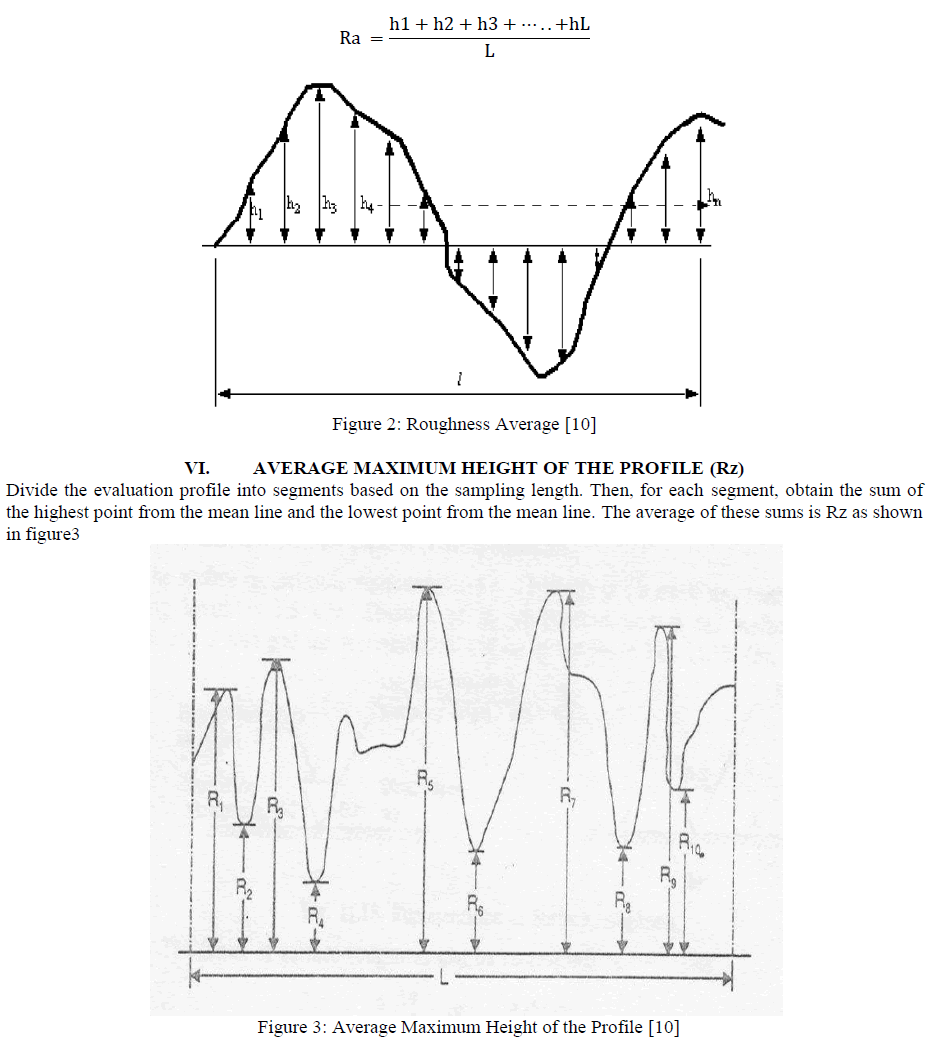 |
VII. METHODOLOGY |
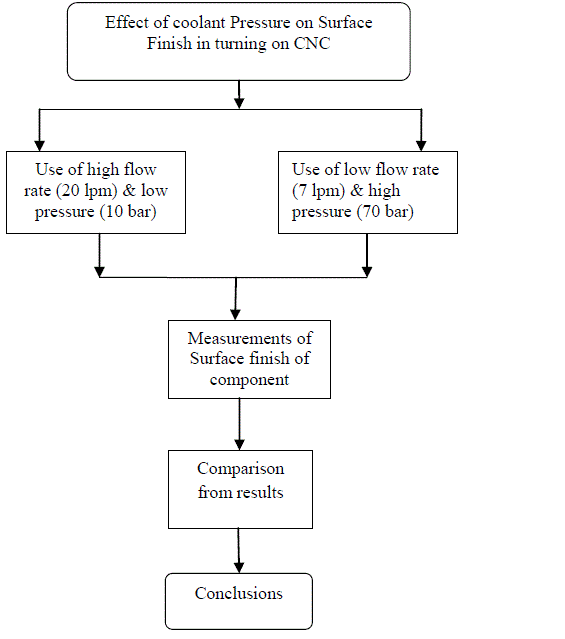 |
VIII. EXPERIMENTATION |
| The experiments are performed on Maxturn plus CNC Machine with high pressure pump set attachment. The set up is shown in figure 4. The high Pressure coolant attachment is prepared to supply high pressure coolant during turning operation. The fixed parameters in the experimentation are as follows ïÃâ÷ Work material – EN8 Steel ïÃâ÷ Machining method – Turning ïÃâ÷ Tool – Single point cutting tool ïÃâ÷ Tool insert – DNMG (IC320), WNMG (IC9015) ïÃâ÷ Cutting Conditions (speed, feed, depth of cut) Speed – 2000 rpm Feed – 0.1 mm/rev. Depth of cut – 0.2 mm ïÃâ÷ Coolant – Water base Ashoka LD-700 The variable parameters of experiment are as follows ïÃâ÷ Flow rate of coolant ïÃâ÷ Pressure of coolant |
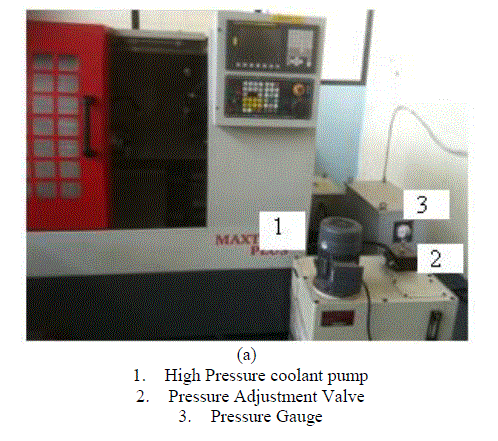 |
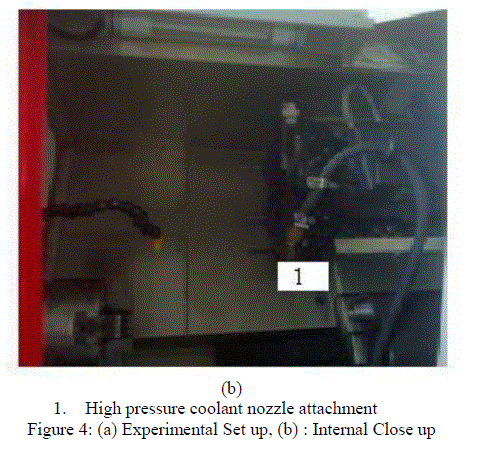 |
| The component for study is threaded nipple shown in figure 5. This is used for supplying the oil to the engine. On this component various machining operations are performed. For present study the turning operation on hexagonal bar of 25mm size is selected. |
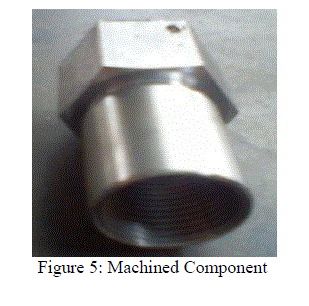 |
| The Surface finish of machined component is measured by Mitutoyo Surface Roughness Tester SJ-201 as shown in figure 6and Table 1 shows Roughness Average (Ra) value of components. Table 2 shows Rz value of components. The readings are taken for every 10th component machined at pressure 10 bar & pressure 70 bar and compare the component up to 160 component were the tool is change at 10 bar pressure. |
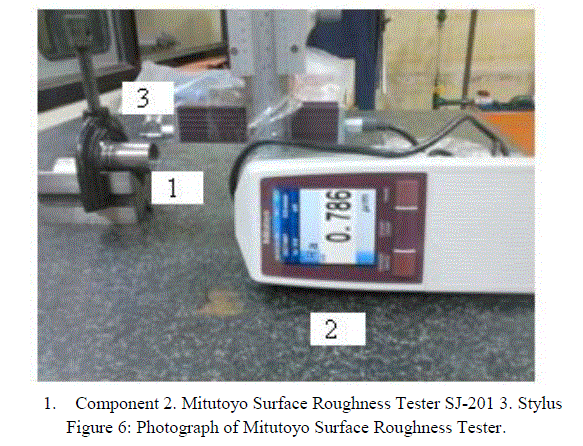 |
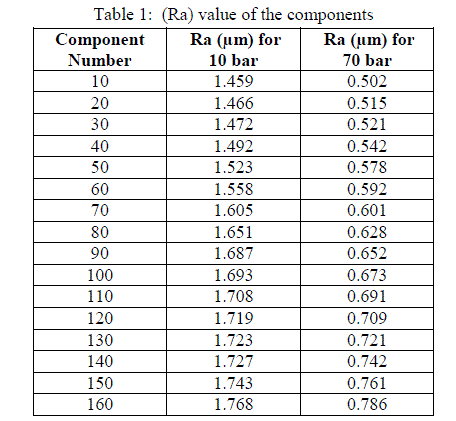 |
| From the above results, Graph of Component No. v/s Ra value is plotted. It gives trend and comparison between surface finish at pressure 10 bar and at pressure 70 bar. From figure 7 it can be seen that component machined using high pressure coolant have better surface finish as compared to component machined using low pressure coolant. |
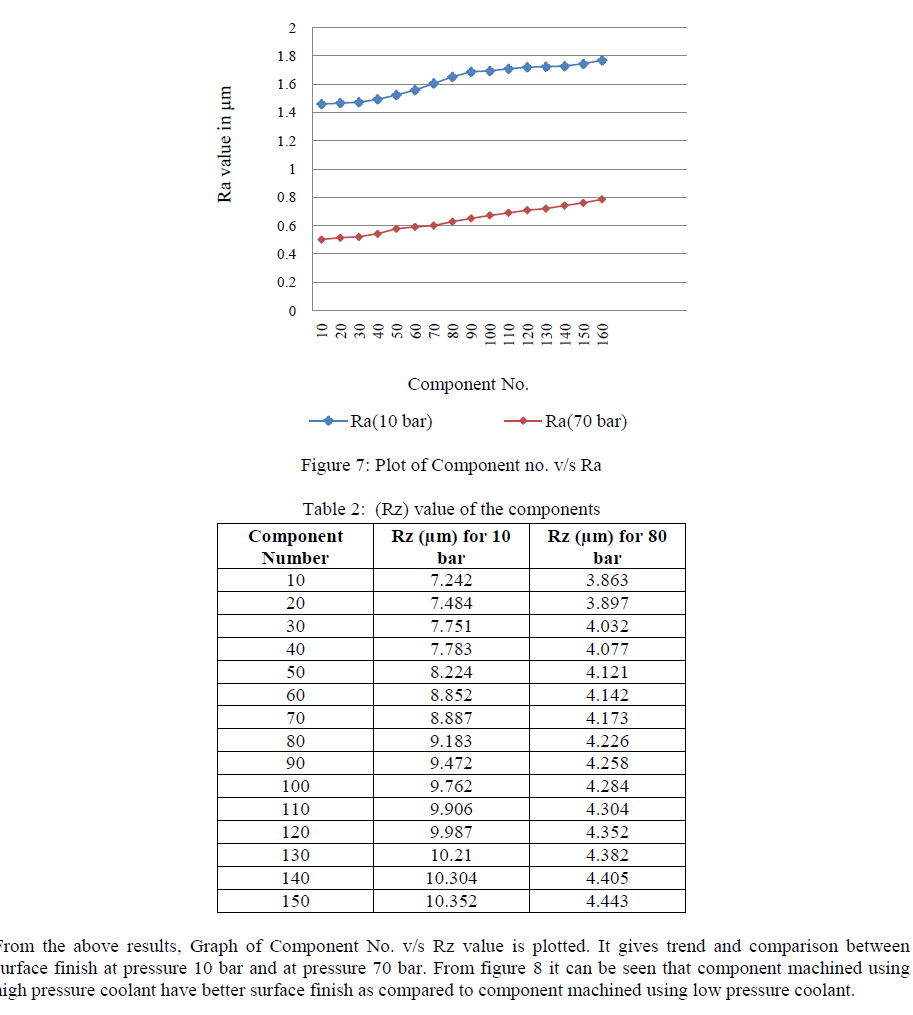 |
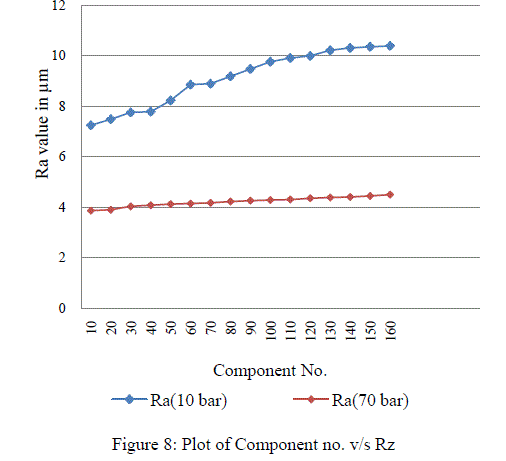 |
IX. CONCLUSIONS |
| a. Use of high pressure coolant improves the surface finish considerably. |
| b. At low pressure (10 bar) the minimum surface roughness value is 0.978 μm and maximum surface roughness value is 1.687 μm. At high pressure (70 bar) the minimum surface roughness value is 0.542μm and maximum surface roughness value is 0.817μm. |
| c. Surface roughness shows increasing trend for both low pressure (10 bar) as well as high pressure (70 bar) coolant supply. This is due to tool wear. |
| d. Surface finish of 200th component (0.817μm) machined using high pressure coolant (70 bar) is less compare to the 1st component (0.978 μm) machined using low pressure coolant (10 bar). |
| e. At low pressure (10 bar) the minimum average maximum height of the profile value is 7.242 μm and average maximum height of the profile value is 10.352 μm. At high pressure (70 bar) the minimum average maximum height of the profile value is 3.863μm and maximum minimum average maximum height of the profile value is 4.443. |
References |
Keywords |
| humic acid, salinity stress, relative growth rate, common bean(P. vulgaris L.) |
INTRODUCTION |
| All plants are subjected to multitude of stresses through-out their life cycle. Salinity stress is one of the major a biotic factors limiting legume plant growth and yield in arid and semi-arid regions [1; 2 and 3] and salinity has direct harmful effects on numerous plant species [4; 5 and 6].It could be caused by (i) salts accumulated in the top layer of the soil due to over-irrigation, (ii) poor irrigation water which contains considerable amounts of salts (iii) neighborhood to the sea, and (iiii) the capillarity rise of salts from underground water into the root zone due to excessive evaporation.Further, salinity reduces the ability of plants to utilize water and causes a reduction in growth rate, as well as changes in plant metabolic processes [7]. Under saline conditions, plants are stressed in three ways; (1) water deficit due to reduced water potential in the root zone, (2) nutrient imbalance by depression in uptake and/or shoot transport (3) phytotoxicity of ions such as Na+ and Cl-[8;9 and10]. This is attributed to the fact that Na+ competes with K+ for binding sites for cellular function [11]. |
| Humic acid (HA) are the main fraction of humic substances (HS) and the most active components of soil and compost organic matter.HA can enhance nutrient availability and improve chemical, biological, and physical soil properties [12; 13; 14and 15].The direct and indirect beneficial effects of HA on plantgrowth and development are their effect on cell membranes which lead to the enhanced transport of minerals, improved protein synthesis, plant hormone-like activity, promoted photosynthesis, modified enzyme activities, solubility of micro-elements and macro-elements, reduction of active levels of toxic minerals and increased microbial populations [16]. In addition, HA introduced as good accumulators of toxic heavy metals [17 and 18].However, there are few studies about the changes induced by the application of HAon plant structures and process in abiotic stresses, especially salinity conditions[19; 20; and 16). |
| The common bean (Phaseolus vulgaris L.) is the most important and vital leguminous crops in the semi-arid areas among the Asian countries i.e., China, Iran, Japan, and Turkey are the major producers of the common bean. Besides providing high quality protein for human consumption.The main goal of this dissertation was the assessment of humic aid supply in combination with salinity levels on morphological parameters and plant biomass of common bean plants. |
MATERIALS & METHODS |
Experimental site: |
| This investigation was carried out during the summer of 2013 at the research greenhouse at the horticultural unit of King Abdul-Aziz University, Jeddah,Saudi Arabia. The green house is assigned at the following conditions; photoperiod (16 h light and 8 h dark) and the average temperature was 25°C/21°C day/night.Randomly, the soil material was collected from surface layer (0–15 cm) at the private agricultural farm, North of Jeddah city from an area of 1 ha.Soil sample was air dried. |
| Plastic pots measuring 50 cm in height and 20 cm in diameter.Each pot was filled with 5 kg of soil and soil characterization was done according to standard procedures: particle-size distribution using the pipette method [21], soil field capacity [22], total carbonate [21], soil pH (saturated soil paste)[22], total soluble salts (electrical conductivity of saturated soil paste extract) [23]. Concentrations of available nitrogen, phosphorus, and potassium were determined as described by Hesse[24]. Available nitrogen was extracted using KCl (2.0 M), available phosphorus was extracted and determined using the Olsen method (extracted using NaHCO3 [0.5 M] at pH 8.5 and determined colorimetrically after treating with ammonium molybdate and stannous chloride). Available potassium was extracted using ammonium acetate (1.0 M) at pH 7.Some physical and chemical properties of the investigated soils are shown in Table 1. |
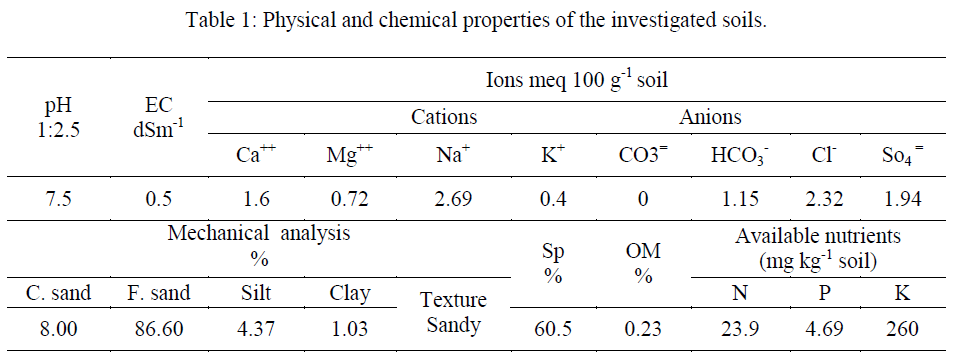 |
Experimental layout and salt treatment: |
| The experiment consisted of four salt treatments as the following;0, 25, 50 and 100mMNaCl combined with and without humic acid (HA).HA(made in Germany) in a solid form as potassium humate (85%) was applied to the soil at the rate of 3g L-1 and given as liquid to the soilat three equal doses. The chemical analysis of humic acid is shown in Table 2. |
 |
| The experiment was set up in split plot design with a completely randomized block design, and each treatment was replicated three times.Prior to planting, all seeds were inoculated with rhizobium strain (Rhizobium leguminosarumbiovarphaseoli). Finally, NaCl treatments were initiated 10 days after sowing. |
Seed germination and growth: |
| Nine seeds of common bean cultivarStrike (Phaseolus vulgaris, L.)obtained from Hollandwere sown in each pot and these were thinned to 3seedling in each pot 10 days after planting. During the growing period, the seedlings were frequently irrigated with water previously prepared with different concentration of NaCl salt. Moisture content was monitored regularly by supplying the plants with equal amounts of water to ensure that the pots were not moisture deficient. |
Plant growth measurements and sampling: |
| After 5 days after NaCl salt treatments, measurements were taken three times (at15 days intervals), each time, plant morphological parameters such as plant height, number of leaves, root length, shoot and root fresh weight were measured. |
| Roots were immersed in tap water and then in de-ionized waterto clean them and thenroot and shoot were dried in an oven at 70oC for 48 h. Dry root and shoot biomass were recorded. Leaf chlorophyll contents were measured using Minolta SPAD chlorophyll meter and leaf area (cm2/plant)was calculated by the following equation:[(Fresh weight of leaves x 10 x punch area (cm2)/fresh weight of 10 disks] x100. |
| Finally, the relative growth rate (RGR) was estimated during two periods at 30 and 45 days after planting (DAP) using the following equation: |
| (RGR) =(lnW2 – lnW1/t2-t1) |
| Where, W plant weight (mg), t the time (days), and the subscripts 1 and 2 are initial and the 2nd sampling of biomass. |
Statistical analysis: |
| Data were statistically analyzed using descriptive statistics and analysis of variance (ANOVA). Based on a two-way ANOVA, the effect of HA application and NaCl salt treatments as well as their interactions were evaluatedaccording to the procedure outlined by Duncan[25] using CoStat (Version 6.303, CoHort, USA, 1998–2004). Means of treatments were considered significantly different using the least-significant-differences test (LSD) at the confidence level of 5% according to Gomez and Gomez [26]. |
RESULTS AND DISCUSSION |
Plant morphology: |
| A glance on Table 3, the summary of the statistical analysis for the morphological parameters clear that soil application of humic acid (HA) significantly (P≤ 0.05)increased plant height, number of leaves and root length at 15, 30 and 45 days after planting (DAP),respectively. While, no significant differences were observed for root length at 15 and 30 DAP, respectively. |
| The analysis of variance for studied parameters during the dissertation appeared that salinity stress had adversely reduced the plant height, number of leaves and root length of common bean measured at 15, 30 and 45 days after planting (DAP) as salinity increased. Differences in studied parameters were highly significant (P≤ 0.01) among the salinity levels with the exception of number of leaves at 15 DAP (Table 3).This reduction under high salt stress (100 mMNaCl) as observed in this dissertation explains a toxic impacts from high ion concentration in plant tissues. |
| Corresponding with the obtained results, there were previous studies have reported that plant height in legumes such as P. vulgaris was declined under salt stress [1 and27]. |
| It was clear that plant growth markedly influenced by all applied salinity levels with a variance degree (Table 3). With the low level of salinity treatments, application of HA had pronounced effect on plant height, number of leaves and root length. On the other hand, the reduction was observed with the highest salinity treatment receiving no HA applications. Nevertheless, it was noticed that the application of HA maximized the adverse effect of salinity stress and the performance of morphological parameters of common bean plants meanwhile not to the level of plants grown under appropriate conditions (non-saline). The observed mitigating effects were true for all recorded plant growth parameters namely plant height, number of leaves and root length. |
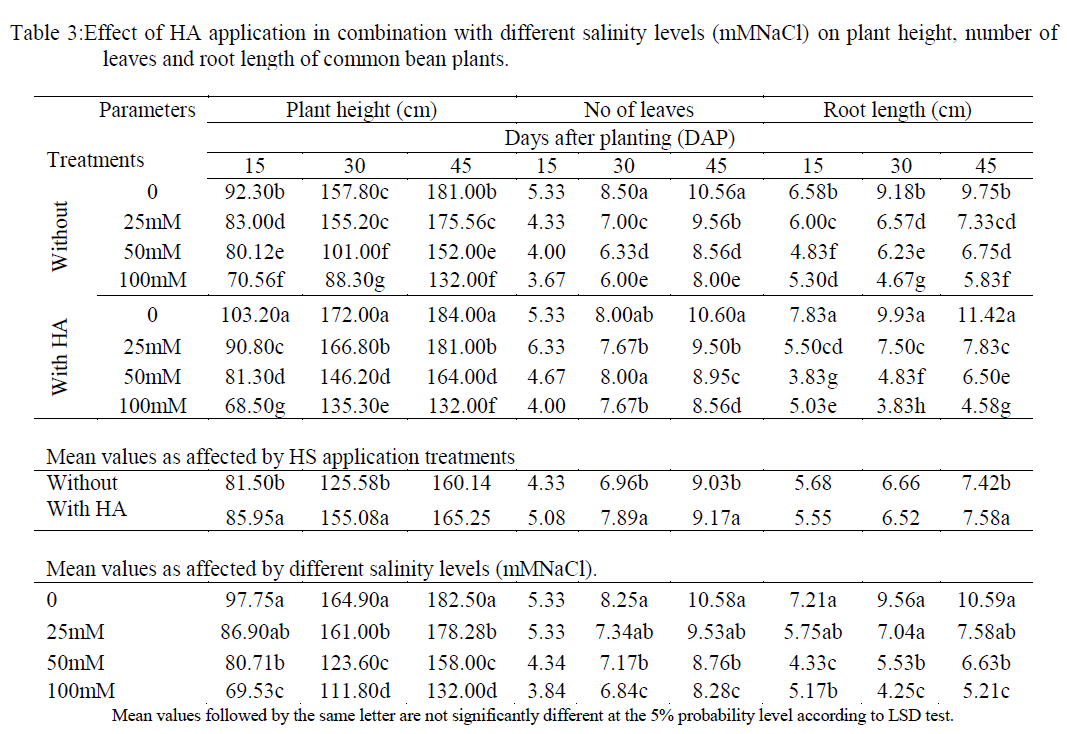 |
Plant biomass measurements: |
| The obtained results during the study revealed that plants received HAsignificantly mitigated shoot and root fresh weights (g plant-1) at 15, 30 and 45 DAP respectively as compared to untreated plants (Table 4). Contrary, no significant responding was found with respect to shoot fresh weigh at 15 DAP and root fresh weight at 30DAP, respectively. Furthermore, dry shoot and root biomass were significantly enhanced by HAaddition as compared to the control at three plant growth intervals (Fig.1). Meanwhile, shoot/root ratio tended to enhance due to HAaddition comparing with the control but there is no significant differencesat three harvests. There was an increase in shoot/root at 30 DAP which then dropped markedly at 45 DAP (Fig.1). |
| The observed enhancement of plant growth using HA application had been reported earlier to be due to increase elements uptake such as N, P, K, Fe, Zn, and Mn nutrients [13; 14 and 15]. Moreover, enhancement of photosynthesis, chlorophyll density and plant root respiration has resulted in greater plant growth with HA application [28]. This performance in the plant growth most probably was due to enhance in moisture retention and the improvement of nutrients supply in the root zone [29 and 30]. |
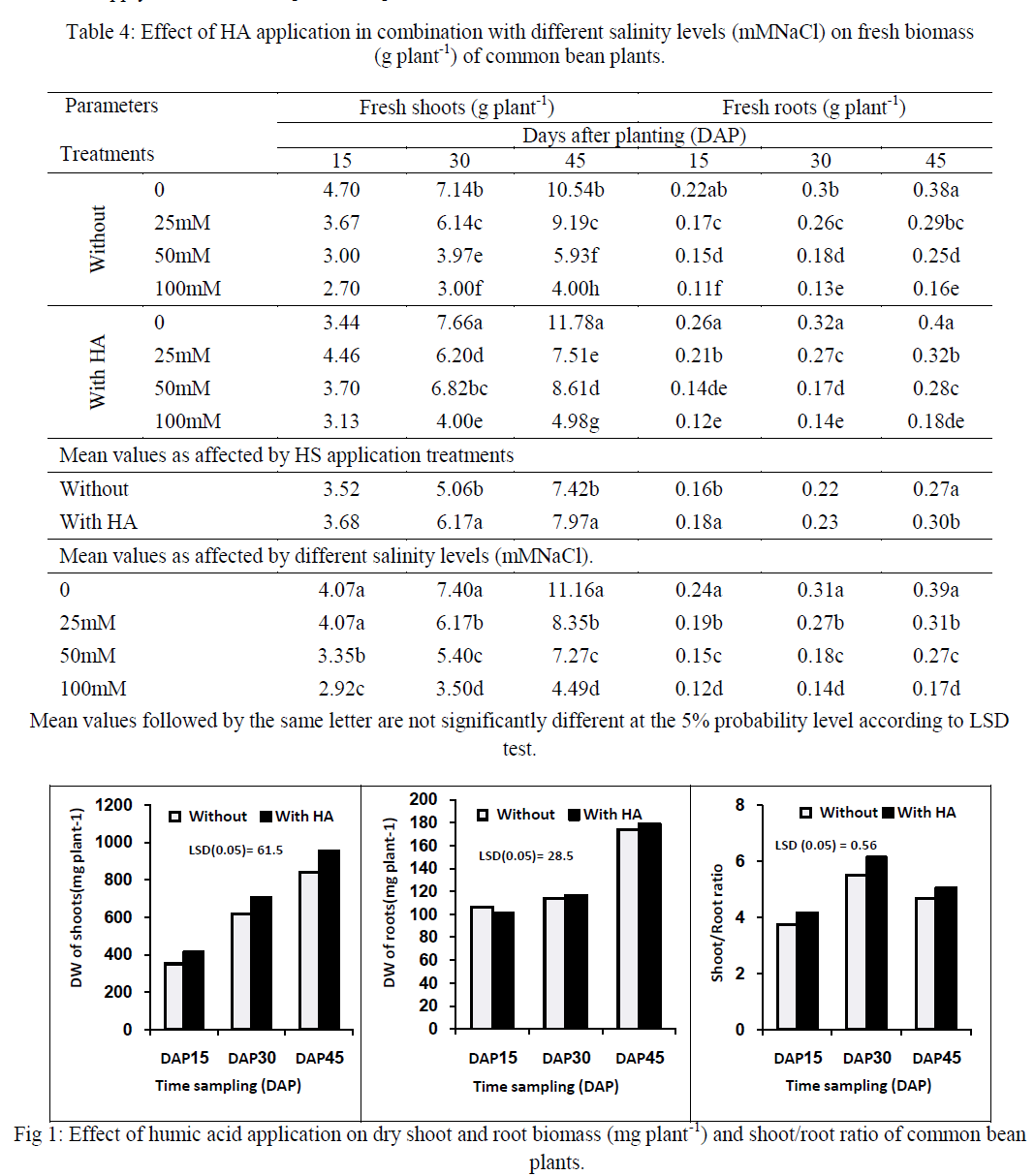 |
| The effect of salts stress on fresh and dry biomass of common bean plants were examined at 15, 30 and 45 DAP, respectively (Table, 4 and Fig. 2). Increasing salinity level above control significantly reduced all plant growth parameters namely fresh shoot and root biomass at 15, 30 and 45 DAP, respectively (Table 4). Further, there was a negative relationship between salinity levels and dry biomass which was significantly correlated with the salinity levels (Fig. 2). The reduction in fresh weight was 25, 12 which then jump up to 32% as the salinity increased from optimal 25, 50 and 100 mMNaCl at 45 DAP, respectively. Shoot/root ratio were also significantly different as the level of salinity increased (Fig. 2). The best shoot/root ratio was 6.01 occurred in 50 mMNaCl salinity at 30 DAP. On the other hand, the lowest ratio was 3.46 found in non-saline (control). Further, it was notable that there was an increase in shoot/root ratio at 30 DAP which declined markedly at 45DAP as shown in Figure 2. It seems that the observed reduction in plant biomass may be due to a combination of slower growth and development. This has been attributed to the osmotic stress, restricted photosynthesis mainly because of salt induced changes in photosynthetic apparatus and sinks capacity [4 and 31]. In Phaseolus vulgaris, concentration of 50 mMNaCl caused stunted growth due to salt-induced reduction in photosynthesis [32]. |
| Results collected in Table (5) reveal the combined effect of HA application rates and salt stress levels on dry shoot and root and shoot/root ratio at 15, 30 and 45 days after planting, respectively. The highest descending was associated with the salted plants with highest salinity stress (100 mM) in absence of HA application. On the other hand, the plants grow at HA only give the highest values of dry shoot and root biomass and shoot/root ratio during the different plant growth intervals. It was notable that the application of HA alleviated plant growth and improved biomass measurements of green bean plants. This highest mitigating effect of HA supply on fresh shoot reached about 45.19 % at 50 mMNaCl treatment. Moreover, the highest alleviation effect of HA supply on fresh root was reached about 12.5 % at 100 mMNaCl treatment. In this concern, HA might show anti-stress effects under salinity conditions and it may enhance the uptake of nutrients and reduce the uptake of some toxic elements [20 and 33]. However, there are very few researches of HA application and its effect on the condition of salinity [19]. |
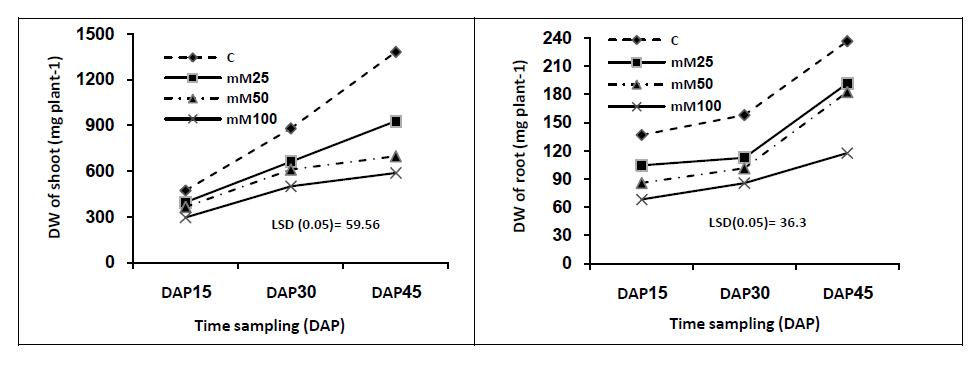 |
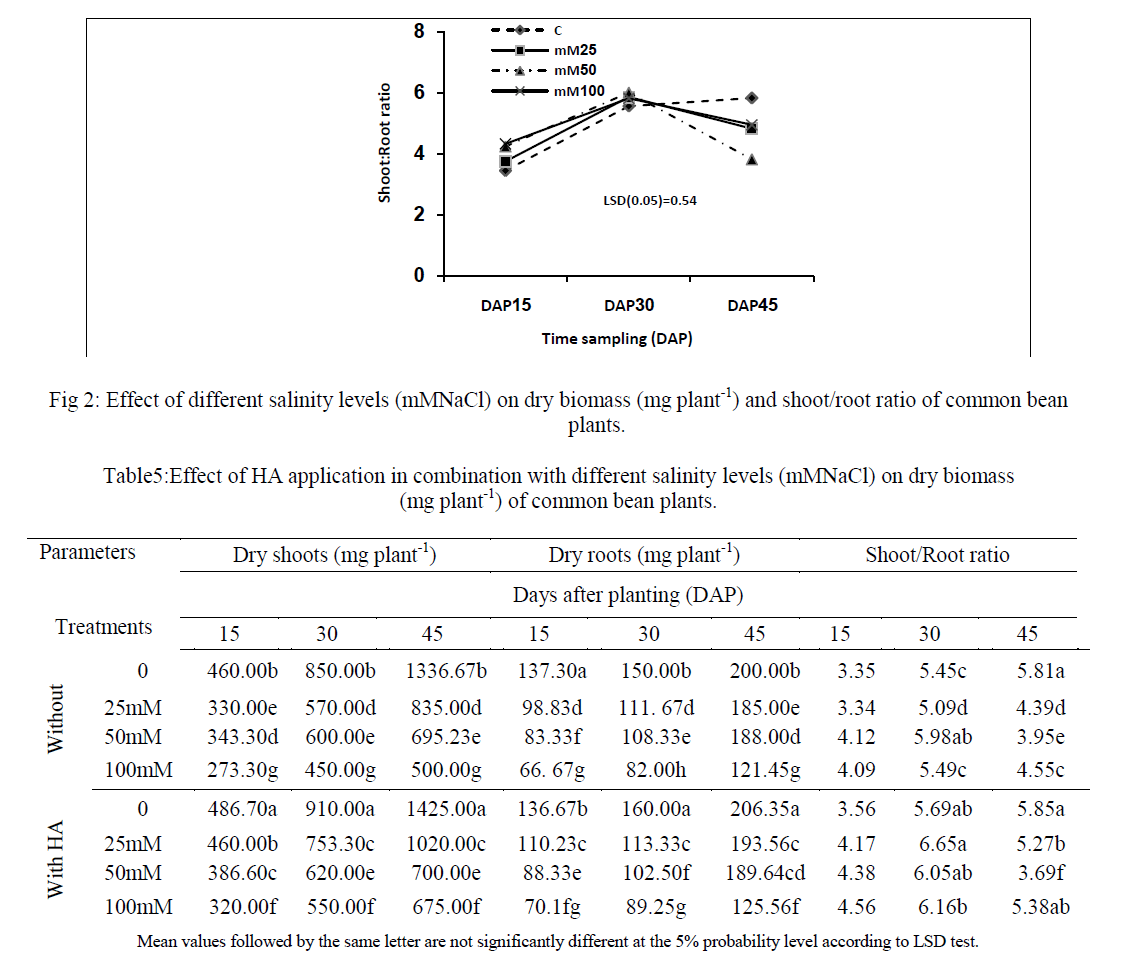 |
Chlorophyll readings (SPAD) and Leaf area parameters: |
| A glance Figure 3, generalstrong increases in values of chlorophyll readings (SPAD) and leaf area (cm2) were observed in almost plants treated with HA as compared to untreated plants under all NaClsalt treatments.Humic acid may be caused an enhancement in the synthesis of the chlorophyll [12] and/or delayed chlorophyll degradation in the two different types of leaves, primary and lateral shoot leaves. |
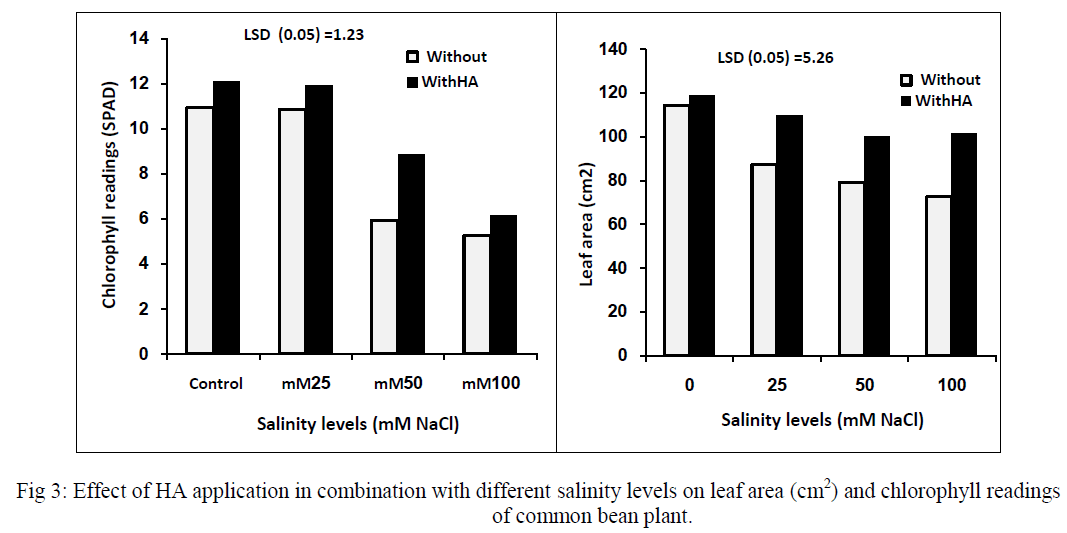 |
| In respect of use HA application in combination with the different salinity levels, results obtained in the current experiment seem to suggest that even application of the HA was able to increase SPAD values under salt stress treatment and consequently leaf area in the common bean leaves (Fig. 3). It seems that HAcan facilitate respiration and photosynthesis processes via modified functioning of mitochondria and chloroplasts [12 and 34]. So, the negative effects of a biotic stresses on plants can be alleviated by the use of HA[16; 34 and 35). |
Relative growth rates (RGR): |
| Alternatively, relative growth rate (RGR) has been used as a relative basis on which to compare growth rates of plants. A crossthe effect of HA and NaClsalt treatments on relative growth rate(RGR) of common bean parts (shoot & root), Figure 4 illustrate that the relative growth rate of plant parts highly significant influenced by HAapplication under the different salinity levels. |
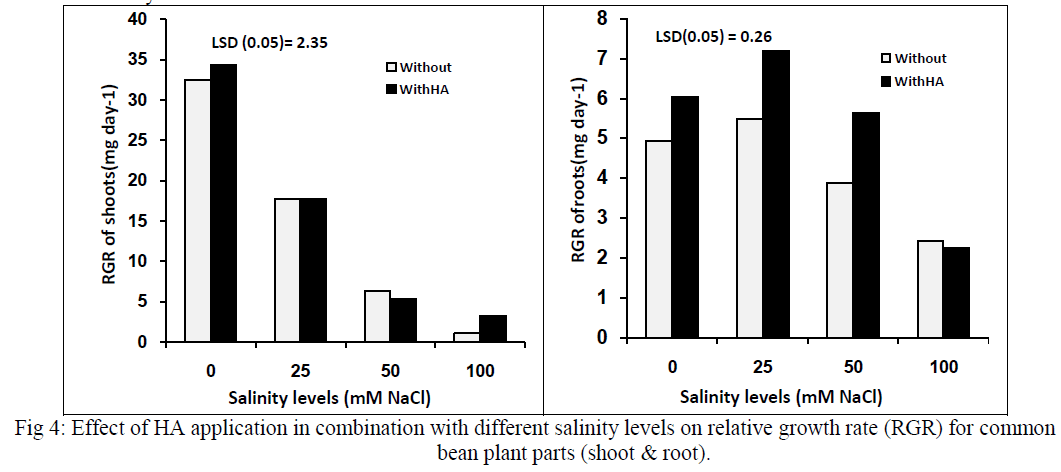 |
| The results presented show that the application of HAhad promoting effects on relative growth rate and alleviating ones on damages caused by the salt stress. The highest relative growth rate of shoot was occurred with the HA supply under non-saline conditions as compared with the others. Contrary, the highest relative growth rate of root was observed when HAsupply under the saline condition of 25mMNaCl and then declined considerably thereafter. |
| In addition,there are closely linear relationshipsamong the relative growth rates of plant parts (shoot & root) and whole plant (RGR) for common bean plant exposed a biotic salinity stress.A highly significant relation (r2 = 0.97, n = 24, P> 0.05), can be plotted in relative growth rate of shoot versus relative growth plants received HA under salinity stress. Meanwhile, scatter plot indicated that there is a significant relation can be predicted in relative growth rate of root and relative growth rate of whole plant (r2 = 0.51, n = 24, P> 0.05) supplied with HA under salinity stress conditions. |
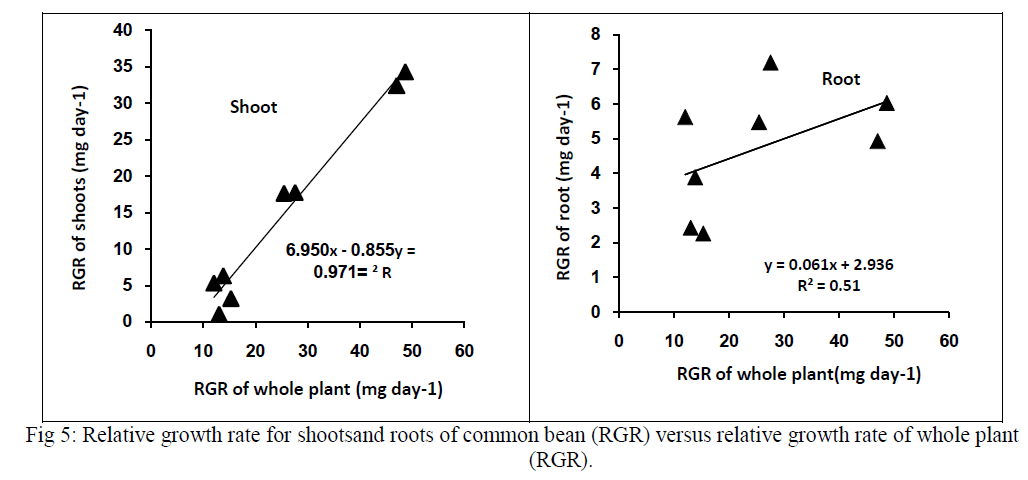 |
| Under steady state conditions, the relative growth rate among plant parts should be equal [36].The higher relative growth rates of shoot, the faster total growth rate of the plant. Shoots growth rate for common bean was more rapid than roots growth performance as exposed by a biotic stress conditions. |
CONCLUSION |
| Results obtained in the present work confirmed that humic acid was able to produce some positive effects in common bean(Phaseolus vulgaris, L.). In particular, significant improving fresh and dry biomass andchlorophyll contents as well as relative growth rate have been observed due to humic acid application under different salinity stress. Consequently, supply of humic acid markedly alleviated the negative effects of a biotic stresses on common bean plants and is considered as a promising soil amendmentto overcomeadverse effects ofsalinity stress. |
References |
|